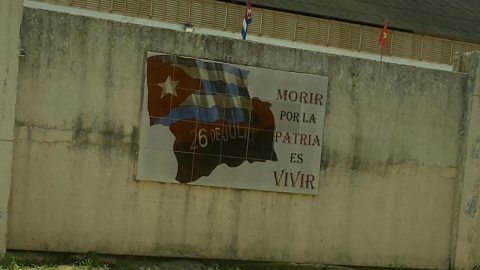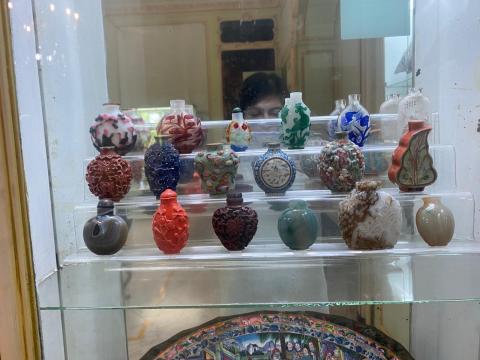Summer in Cuba: The Introduction to Havana
Our 2025 Summer in Cuba program has started. Eleven students landed in Havana on May 21 for a month-long stay. They will explore the island’s contemporary social and cultural landscapes, learning from local civic and artistic leaders, and visiting important national sites. Millicent Helmka, a Philosophy major at Tulane, will be delivering weekly articles from the field and keeping us updated on their journey. Read her first reflection below.

When I told my friends about my upcoming trip to Cuba, I saw a bit of fear in their faces. My parents were similarly dismayed. To give them credit, their fear and skepticism is not unexpected. Cuba is not exactly given a great rap by the American political sphere nor American media. Still, I felt that this typical American concept of Cuba and its citizens had to be exaggerated someway. So, I decided to take on the task of documenting this journey to show that Cuba is a place like any other: a product of the dense context of history and geopolitics, it has its rich and its poor, a sense of isolation and globalization at the same time, and the two polarities of capitalism and communism butting heads. It's a place of contradictions and constant change, but that is not unique to the island at all. What is different is that it cannot hide its nuances as well as the colloquial “First World” can. So, what I hope to illustrate with my journals is the character and everyday challenge of the Cuban people, el pueblo, and the country’s unique place in geopolitics. I greatly thank the Stone Center for allowing me the opportunity to do so.
Summer in Cuba is a month of studying and living in Vedado, a relatively affluent neighborhood of Havana built before the revolution of 1959. The urban planning of Havana is quite striking. Residential lots are usually four or more story buildings housing multiple families with no side-yard separating each one. It is the equivalent of the New Orleans Uptown, and just as exciting, every other building cyan or decorated with intricate stonework. The peachy pink building our group is staying in is owned by Aleida, a lovely Afro-Cuban woman, and her family. This, which we might call a bed and breakfast in America, is known as a casa particular in Cuba.
My first step in adapting was realizing all I take for granted in the United States. Now possessing a Cuban phone number, I began using the datos, or cellular data provided by the Cuban state company ETECSA. This gave me the ability to access apps like Instagram (but Tiktok is banned) and to communicate via WhatsApp to my professors, classmates, and family. The data, and the internet itself, are generally inconsistent. So, most of our work would be done without the internet, and the files we’d need for class were shared on a hard drive. Most jarring is the inconsistent utilities: electricity and water. Cuba is infamous for its weak power grid and “scheduled outages” that often lead to protests in the rural areas. On our third night here, what had only been more or less two hours of darkness and no A/C had been thirty-six hours for a town called Bayamo. Protests followed. Some, like the “hardliner” U.S. representatives, say that this is entirely the fault of government mismanagement, and others, such as left-wing activists, say the responsibility falls on the U.S. and the embargo.When driving anywhere in Cuba, you’ll see billboards with pop art and Castro’s face peppering the Cuban landscape, words written: tumba el bloqueo!
The next day, my parents told me that their power in New Orleans, along with tens of thousands others, had been out for some untold reason. I found myself contemplating. When the power does go out in our little spot in Havana, so too does all the white noise. I find my life to be slower than usual. Things are so much less busy here in Cuba, even as so many hustle to make a better living than what their state salaries have to offer. In the silence I remember an Anthony Bourdain quote about Cuba: “the future is here, but the past, too, is everywhere.” That’s evident by the cars here. Everyone knows about the cars. I’m no car person at all, but even I think the Cubans’ dedication to these old machines is something magical.
The water pressure here is often low, and one must conserve water and cannot flush the toilet paper. You have to be strategic about what day you wash your hair, and it is not safe to drink straight from the tap (our casa particular boils and filters it). Still, I see it as both a challenge and a lesson. The life of the American is not the life of the average person when you consider all eight billion. In both Cuba and the United States I am lucky to have healthy food and clean water and a roof over my head.
On that first Friday, we were visited by Rafael Hernández, editor of Temas magazine, who spoke to us about the new constitution ratified in 2019, and other new developments in local Cuban politics. The next morning we toured Habana Vieja, or Old Havana. It was very French Quarter like (in that the architecture is actually colonial Spanish), with those boxy shapes, many balconies, and recurring archways providing shade. Musical artists were on every corner and many others sold their wares or street food. After our tour, we visited the Museo de Bells Artes and its Cuban collection (there is another with a global collection). We had lunch not far from that museum, and there I discovered my favorite Cuban staples so far: ropa vieja (shredded beef) and croquettes (deep fried breaded balls with various fillings).
Our two classes, one on Cuban theater and the other on films, began the following Monday. We have classes on Mondays, Tuesdays, and Thursdays. The remaining days are free unless something else has been scheduled, such as our visit to Hershey, now known as “Camilo Cienfuegos,” a town previously dedicated to harvesting sugarcane for the famous chocolate brand. The town had its own unique culture and small economy centered around the company, and was architecturally modeled after houses in Pennsylvania. Although Hershey sold the land back to Cuba in 1948, the town continued to produce sugar. However, the mill that was the town’s heart closed in 2002, and economic decline followed. Now, some entrepreneurs are working with the community to make it a spot for historical intrigue and artistic creation to revitalize the town with tourism.
Then, Monday, it was back to studying and wandering Vedado during my free time. I’ve had plenty of good meals and a few bumps in the road (many of us have been briefly ill), and so many new anecdotes and historical facts to share when I get back. There’s still plenty of places for me to visit, locals to talk to, and new stories to read and learn about. It is definitely a little overwhelming, but my classmates and I are taking all the new challenges in stride.

—
Summer in Cuba is a 4-week summer program sponsored by the Stone Center for Latin American Studies and the Cuban and Caribbean Studies Institute at Tulane University. It caters to undergraduate Spanish students seeking a unique, immersive linguistic and cultural experience in Cuba. You can learn more about the Summer in Latin America programs here.
RELATED NEWS
Summer in Cuba: In the Swing of Things
Summer in Cuba: Over Halfway There
